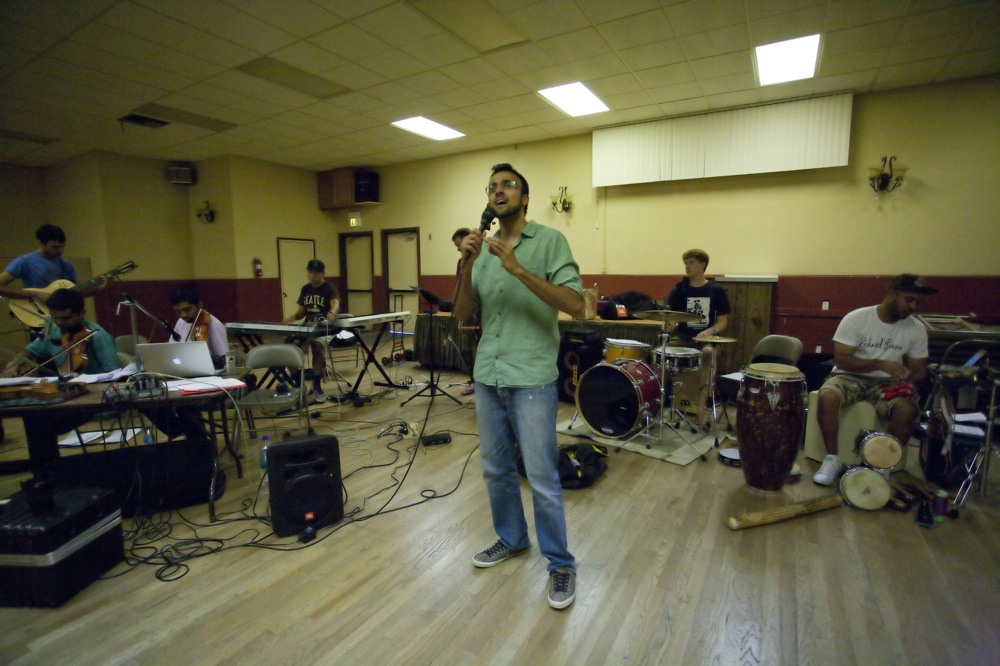Aditya Prakash Ensemble blends jazz, classical Indian music

The Aditya Prakash Ensemble blends an unconventional pair of genres, jazz and classical Indian music.
By Shreya Aiyar
Sept. 22, 2013 12:00 a.m.
Over the last three years, the Aditya Prakash Ensemble has played host to a family reunion of musical genres.
In its compositions, the ensemble’s unconventional comtemporary style – an ascending scale voiced by an Indian classical singer, a dissonant riff played by a Brazilian guitarist – unites the Indian classical music style with its much younger American sibling: jazz.
The Aditya Prakash Ensemble first attained local fame when it performed at UCLA’s JazzReggae Festival in 2011. Since its first public appearance, the group has played at numerous shows, recorded its 2012 debut album, “The Hidden,” and, most recently, performed original compositions for a dance production titled “MARA.”
As a fourth-year ethnomusicology student, Aditya Prakash, now an alumnus, collaborated with classmates, pianist Julian Le and bassist Owen Clapp, to create the Aditya Prakash Ensemble. The group then began to experiment with a new genre of music that combines Indian classical vocals with jazz-influenced brass and percussion sections.
In the group’s earliest stages, Prakash said he and the ensemble members faced some difficulties in understanding the nuances and technicalities of the different musical styles.
In time, however, the group adapted to the medley of genres through careful observation of technicalities, such as improvisation and similar tones, that jazz and Indian classical music have in common.
“It was tough because we had to learn a different culture and consider music from a different perspective, not just the one we were comfortable with,” Prakash said. “But it expanded our thinking process and our way of approaching music as a label-free entity.”
Another difficulty, Prakash said, arose in teaching the mainly jazz-oriented ensemble a foreign genre of music that receives little mainstream exposure in the United States.
An art form dedicated to philosophical and religious thought, the Indian classical music tradition traces its origin to thousands of years ago and is usually heavily improvised and unwritten.
Prakash said he was initially worried that the unfamiliar rhythms and scales that form the foundation of Indian classical music would not strike a chord with listeners, but the group eventually realized the genre’s appeal to modern and foreign audiences.
“There’s no explaining the (Indian classical) music and the style, and there are a lot of technicalities like complex rhythmic patterns and unusual ornamentations that people wouldn’t have heard anywhere else,” Prakash said. “But music just has to be presented in a way that’s easy to digest, and I think combining it with the harmony of Western instruments can make it easier to understand.”
Shiva Ramamurthi, a fourth-year cognitive science and economics student and a violinist in the Aditya Prakash Ensemble, joined the group in 2012 soon before it began recording “The Hidden,” a collection of five tracks that span the compositions of Indian poets from as far back as the 11th century.
Ramamurthi said recording the album brought the group together in more ways than one: The ensemble’s sound solidified and the members found their own performance styles within the group.
“Recording the album was a really cool experience, and it showed me that everyone in the group is so individually talented,” Ramamurthi said. “We all accept each other for our individual talents and we’re not afraid to learn from each other.”
In recording the CD, Ramamurthi said the group’s musical creativity flourished in its original compositions. That same creativity took hold in composing the score for “MARA,” a dance performance led by Prakash’s sister and Indian classical dancer Mythili Prakash that premiered Saturday night at the Ford Amphitheatre in Hollywood.
[Editor’s note: Watch the video below to go behind the scenes of the rehearsal process].
The performance loosely tells the story of Mara, a demonic character from Buddhist folklore who attempts to distract the Buddha from his journey to enlightenment with various images of desire and temptation.
Prakash said the music was made with the intent of depicting the story through the eyes of the main character, a young girl, and describing her triumph over the force of desire.
Nishil Patel, a fourth-year biology and economics student and former external vice president of UCLA’s Indian Student Union, said the Aditya Prakash Ensemble brings a passion for closing the culture gap to UCLA.
The group performed last year in the annual Indian Student Union Culture Show and energized the crowd through the music’s sheer novelty, Patel said.
“The group blends the genres together well,” Patel said. “The act was definitely unique, and I had never heard anything like it in my life.”
Ramamurthi said that in the end, the ensemble is simply a tightly knit group of friends having fun and playing music together to wind down after long and busy days.
“It almost seems like we’re forced to spend time with each other, but we love each other’s company,” Ramamurthi said. “We’ve just become really close through this ensemble and we’re able to play anything that comes our way now.”


